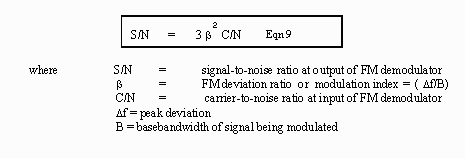

An important aspect of analogue FM satellite systems is FM threshold effect. In FM systems where the signal level is well above noise received carrier-to-noise ratio and demodulated signal-to-noise ratio are related by:

The expression however does not apply when the carrier-to-noise ratio decreases below a certain point. Below this critical point the signal-to-noise ratio decreases significantly. This is known as the FM threshold effect (FM threshold is usually defined as the carrier-to-noise ratio at which the demodulated signal-to-noise ratio fall 1 dB below the linear relationship given in Eqn 9. It generally is considered to occur at about 10 dB).
Below the FM threshold point the noise signal (whose amplitude and phase are randomly varying), may instantaneously have an amplitude greater than that of the wanted signal. When this happens the noise will produce a sudden change in the phase of the FM demodulator output. In an audio system this sudden phase change makes a "click". In video applications the term "click noise" is used to describe short horizontal black and white lines that appear randomly over a picture.
Figure 17: S/N vs C/N relationship for FM modulation, showing effect of FM threshold [Ref 8].
Because satellite communications systems are power limited they usually operate with only a small design margin above the FM threshold point (perhaps a few dB). Because of this circuit designers have tried to devise techniques to delay the onset of the FM threshold effect. These devices are generally known as FM threshold extension demodulators. Techniques such as FM feedback, phase locked loops and frequency locked loops are used to achieve this effect. By such techniques the onset of FM threshold effects can be delayed till the C/N ratio is around 7 dB.
Next Section
Return to Index